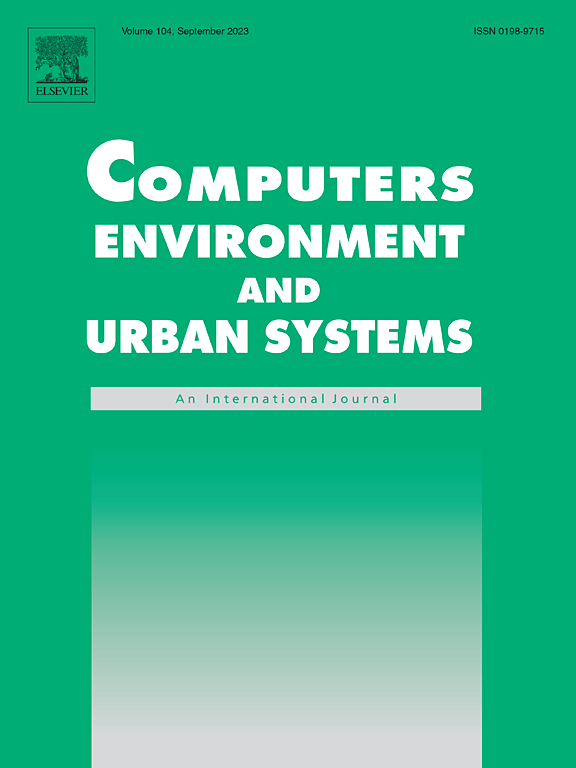Walking smart in the heat: A dynamic shade-oriented pathfinding approach to enhance pedestrian comfort in arid cities
IF 8.3
1区 地球科学
Q1 ENVIRONMENTAL STUDIES
Computers Environment and Urban Systems
Pub Date : 2025-09-11
DOI:10.1016/j.compenvurbsys.2025.102337
引用次数: 0
Abstract
In recent decades, rapid population growth in Middle Eastern cities has led to increased motorization and rising carbon emissions, particularly in car-oriented, high-density urban environments like Dubai. In response, cities are expanding their public transportation systems and promoting walking and cycling. However, scorching temperatures make the choice of active mobility challenging. This study presents a methodology to evaluate pedestrian walking environments by comparing the alignment between the shortest and optimal shadiest paths around metro stations in Dubai. Unlike existing models that apply a constant shade reward, we develop an optimal shadiest path method that assigns dynamic rewards to buildings, trees, and indoor shade, which better reflects real-world conditions. Additionally, we highlight the often-overlooked role of indoor paths in enhancing pedestrian thermal comfort, particularly in arid cities. To quantify both the shortcut effect and the shade improvement of indoor paths, we introduce the Indoor Contribution Index (ICI), a metric that assesses the role of indoor routes in improving pedestrian thermal comfort and walking efficiency. The results reveal that, on average, the optimal shadiest path is 1.3% longer than the shortest path, with an 8.9% increase in building shade and an 8.8% decrease in sun exposure compared to the shortest path. Additionally, both temporal factors and spatial characteristics significantly influence the utility of indoor routes in enhancing thermal walking comfort. Our findings highlight the need for further research into smart pathfinding algorithms that can guide pedestrians through hot environments, as well as the integration of indoor networks into urban mobility systems, particularly in Middle Eastern cities and other regions with harsh outdoor conditions.
在炎热中聪明地行走:一种动态的以阴影为导向的寻路方法,提高干旱城市中行人的舒适度
近几十年来,中东城市人口的快速增长导致了机动化和碳排放的增加,尤其是在迪拜这样以汽车为导向的高密度城市环境中。作为回应,城市正在扩大公共交通系统,促进步行和骑自行车。然而,炎热的气温使得主动移动的选择具有挑战性。本研究提出了一种通过比较迪拜地铁站周围最短路径和最佳阴影路径之间的对齐来评估行人步行环境的方法。与现有的应用恒定荫蔽奖励的模型不同,我们开发了一种最优荫蔽路径方法,该方法为建筑物、树木和室内荫蔽分配动态奖励,从而更好地反映了现实世界的条件。此外,我们强调了室内路径在提高行人热舒适方面经常被忽视的作用,特别是在干旱城市。为了量化室内路径的捷径效应和遮荫改善,我们引入了室内贡献指数(ICI),这是一个评估室内路径在改善行人热舒适和步行效率方面的作用的指标。结果显示,平均而言,最优荫蔽路径比最短路径长1.3%,与最短路径相比,建筑物荫蔽增加8.9%,日照减少8.8%。此外,时间因素和空间特征都显著影响室内路径在提高热步行舒适度方面的效用。我们的研究结果强调,需要进一步研究智能寻路算法,以引导行人穿过炎热的环境,并将室内网络整合到城市交通系统中,特别是在中东城市和其他室外条件恶劣的地区。
本文章由计算机程序翻译,如有差异,请以英文原文为准。
求助全文
约1分钟内获得全文
求助全文
来源期刊

Computers Environment and Urban Systems
Multiple-
CiteScore
13.30
自引率
7.40%
发文量
111
审稿时长
32 days
期刊介绍:
Computers, Environment and Urban Systemsis an interdisciplinary journal publishing cutting-edge and innovative computer-based research on environmental and urban systems, that privileges the geospatial perspective. The journal welcomes original high quality scholarship of a theoretical, applied or technological nature, and provides a stimulating presentation of perspectives, research developments, overviews of important new technologies and uses of major computational, information-based, and visualization innovations. Applied and theoretical contributions demonstrate the scope of computer-based analysis fostering a better understanding of environmental and urban systems, their spatial scope and their dynamics.
 求助内容:
求助内容: 应助结果提醒方式:
应助结果提醒方式:


